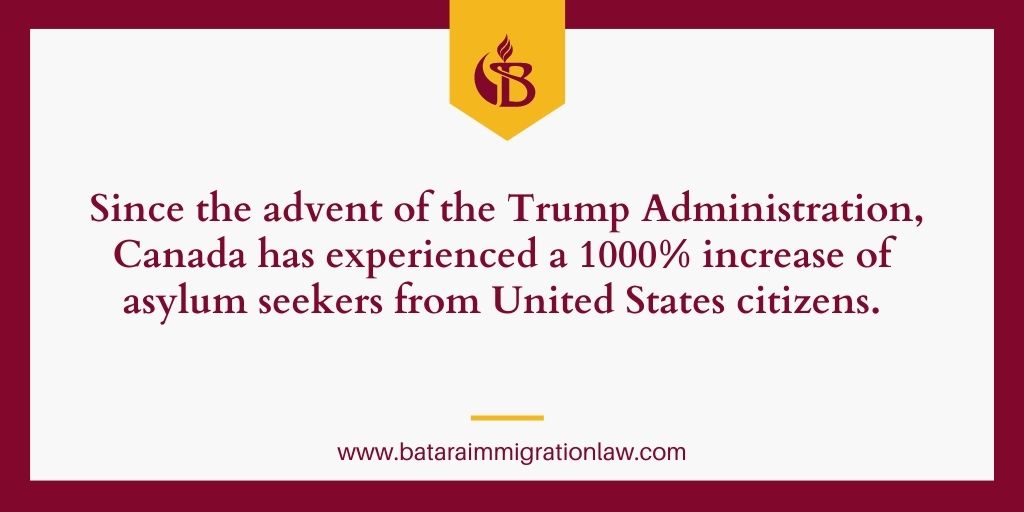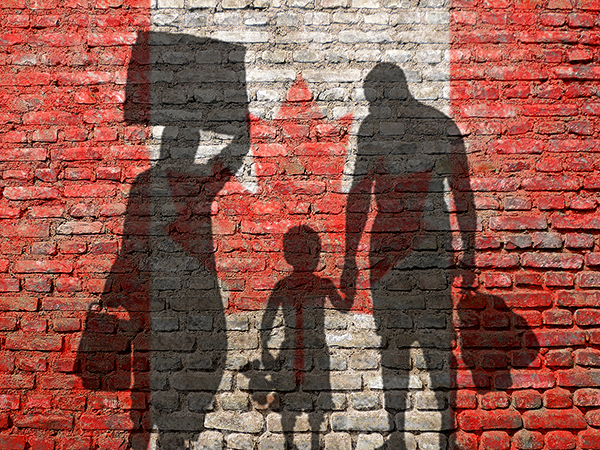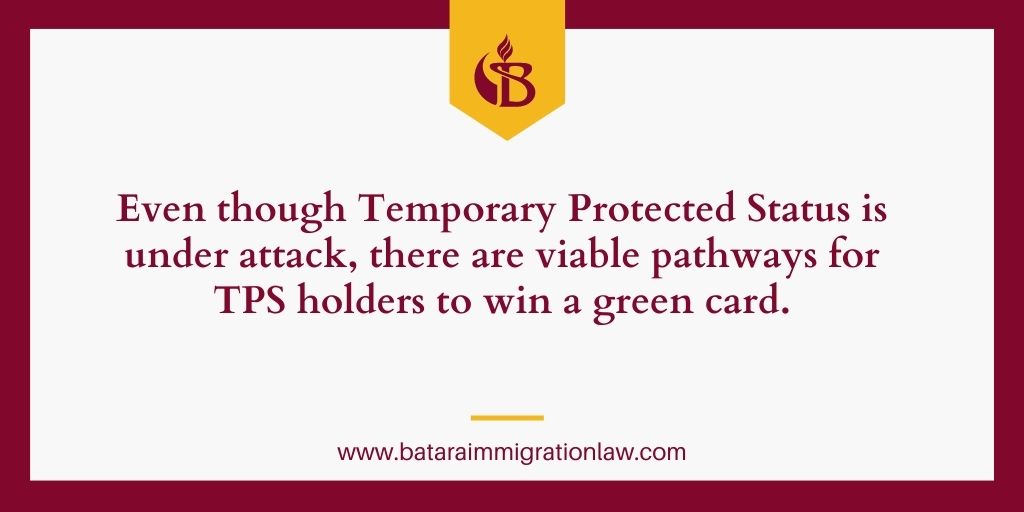
Is Canada the TPS solution?
A few days ago, Samuel, a client from Haiti, visited my San Bernardino immigration office. He wanted to talk about the future of the Temporary Protected Status program.
He worried that winning permanent residency was not in the cards. Samuel knew about the latest efforts to derail the TPS path to green cards through marriage.
Fearing deportation and a forced return to his home country, he confided he had been working on Plan B.
His exit strategy?
Apply for asylum in Canada.
He explained:
“I have a lot of friends who have already moved to Canada. They left as soon as they heard TPS for Haitians was ending. They tell me many people from my home country are living there now, and the community is growing.”
“My wife agrees. My kids were born here. We cannot take them to Haiti if I am deported. The country has not recovered from the 2010 disaster. It’s not a place to raise our family.”
“But Canada is a nice country and we can stay together as a family there.”
“So if I have to go to Canada, yes, that is what I plan to do.”
The Rise Of TPS Beneficiaries Seeking Asylum In Canada
Samuel is hardly alone.
Thousands of Haitian immigrants have fled to Canada since May 2017. The exodus began shortly after DHS announced TPS benefits did not appear warranted past January 2018.
The exact number is unknown.
However, recent estimates indicate the option is not a mere passing fad.
Consider:
- Haitian asylum claims in Canada more than tripled in 2017 and 2018.
- And as of September 2019, about 9,800 Haitian TPS holders had sought asylum in Canada.
This means, out of 50,000 Haitian granted TPS, 19.6% have chosen to relocate, rather than wait for the political ax to fall.
At the outset, the TPS exodus took place at eastern borders. Most of the early refuge seekers sought entry into Canada through Quebec.
According to one report, over 4,700 Haitian TPS grantees living in Massachusetts alone have left for Canada.
However, like Samuel, TPS beneficiaries seeking asylum in Canada are no longer solely confined to East Coast ports of entry.
And the influx is not limited to Haiti TPS holders.
Overall, since the advent of the Trump Administration, Canada has experienced a 1000% increase of asylum seekers from United States citizens.

An escalating number of Sudan, Honduras, Nepal, Nicaragua, and El Salvador TPS recipients are crossing into Canada and filing asylum claims.
The majority are U.S. born children of immigrants – children of Temporary Protected Status beneficiaries.
Their parents fear deportation after living in the United States for several years. They seek a safe haven in Canada.
At the start of the Trump tenure, immigrants from 10 nations had active TPS status. Six have been given notice they are on the government’s chopping block.
Despite efforts by both the U.S. and Canadian governments, there is little reason to believe this trend will end.

How The U.S. – Canada Safe Third Country Agreement Affects TPS Asylum-Seekers
Success, of course, is not guaranteed.
Despite Canada’s more lenient attitude towards immigrants, TPS holders must surmount legal barriers to entry abroad.
In particular, the U.S. – Canada Safe Third Country Agreement that went into effect in 2004.
The accord is built on the premise both nations offer safe refuge. Thus, individuals seeking such protection must claim asylum in the country of their first arrival.
On the surface, this presents a logistical problem for TPS recipients. The U.S. is their first country of arrival.
But the agreement has a major loophole, enabling TPS asylum-seekers.
It only applies to immigrants seeking asylum at official border crossings.
Those who enter Canada illegally are not returned to the United States. The treaty does not apply to them. They can stay in Canada while their claims for asylum are being decided.
And while their cases are pending, they can work and receive health care. Often the process takes several years.
U.S. Asylum Policy On Trial In Canada
In November 2019, a federal lawsuit was filed in Canada challenging this dichotomy. It argued refugees should be able to make asylum claims at Candian ports of entry.
The case was brought by Amnesty International, the Canadian Council for Refugees, and the Canadian Council of Churches.
It asserted the Canada government should withdraw from the Safe Third Country Agreement (STCA) because recent U.S. policies had changed the central tenet of the U.S. – Canadian agreement.
It cites the Trump Administration’s removal of asylum claimants to unsafe countries, unlawful detention measures, barring of asylum claims based on gender and gang violence, separation of families and young children, and criminalizing refugees at the border.
On July 22, 2020, the Canadian court agreed.
Noting that ineligible claimants are returned to the United States by Canadian officials where they are immediately and automatically imprisoned, the court concluded this “imprisonment and the attendant consequences are inconsistent with the spirit and objective of the STCA and are a violation of the rights guaranteed by section 7 of Canada’s Charter of Rights and Freedoms.”
The ruling was delayed by the judge for six months to allow Canada’s Parliament and the United States Congress to respond. To date, U.S. immigration authorities have yet to comment.
If successful, the action would ease the Canadian path to refugee status.
Of course, even adverse actions by Parliament or Congress are unlikely to halt the current flow of TPS asylum-seekers from the United States.
Unfortunately, there are rumblings that the pro-refugee decision will spark a conservative backlash in Canada. Such an xenophobic outcome could lead to decades of legal battles, simiar to those in the United States.
Even without the Canadian Federal Court ruling, the Safe Third Party Agreement dichotomy regarding refugees is not absolute. There are four exemptions to the border-crossing asylum-seeker provisions.
Only one applies to TPS holders, absent rare circumstances.
The exemption?
Asylum claimants with a family member already living in Canada are not turned back, even at a port of entry.
As the number of TPS beneficiaries winning their asylum cases increase, this avenue will likely widen Canada’s doors for close relatives still residing in the United States.
Moreover, the pact does not apply to U.S. citizens.
This has led to an upsurge of Canadian asylum claims made by minor U.S. children.
Minor children whose parents were born outside the United States.
TPS parents.
The pool of youthful claimants is expected to keep growing.
This video explains:
What Should TPS Recipients Consider Before Heading North To Canada?
Is the family unity grass really greener on the Canadian side of the border?
Maybe. Maybe not. It depends.
It depends on the specific circumstances of each TPS family.
That’s a risk TPS recipients take when they head north.
Immigration Policy: The United States vs. Canada
Trump campaigned for office on an anti-immigrant agenda.
Canadian Prime Minister Justin Trudeau promised he would increase the number of refugees.
On the same day that Trump first decreed a Muslim travel ban . . .
Trudeau tweeted, “To those fleeing persecution, terror and war, Canadians will welcome you, regardless of your faith.”
The Trump Administration wants to slash refugee admissions.
The Canadian government boosted the number of immigrants granted permanent resident status from 286,000 in 2017 to 340,00 in 2020.
Given these political divergences, the exodus of immigrants with U.S. citizen children seeking asylum in Canada will continue for the near future.
As a lawyer who helps Temporary Protected Status applicants, I do not feel the trek to Canada should be undertaken lightly.
Every TPS beneficiary considering the trip needs to weigh all their options.
Being safe rather than sorry is the buzzword.
What Is The Likelihood Of Asylum Success By U.S. Residents And Citizens In Canada?
The claims of most U.S. children will be unsuccessful. Asylum law requires proof of a well-founded fear of persecution In their country of origin.
For the children, this means in the United States – not the home countries of their parents.
However, some parents will succeed. They will win permanent resident status and put their entire family on the path to citizenship in Canada.
In 2018, for instance, Canada approved nearly 50% of asylum claims by immigrants crossing their border from the U.S.
It also means 50% of applicants lose.
Green Card Options For TPS Beneficiaries
In The United States
Given the 50-50 odds of prevailing, seeking asylum in Canada is a risky gamble.
In other words, a comprehensive analysis of their chances for permanent residence in the United States before they leave is warranted.
This advice applies to both past and present beneficiaries.
Under certain circumstances, abandoning the U.S. may worsen the odds of success.
Even though Temporary Protected Status is under attack, there are viable pathways for TPS holders to win a green card.

As noted in How TPS Beneficiaries Can Win Permanent Residence (Even If TPS Is Terminated), the primary roads are adjustment of status and cancellation of removal.
Let’s take a brief look at how seeking asylum in Canada could affect them.
The danger arises if a TPS recipient gets into Canada, then fails in their asylum bid. By departing the U.S., they forfeit their place in the residency lines for both programs. They cannot return to the U.S. and regain their prior eligibility.
For instance, some TPS recipients married to U.S. citizens can file for a marriage-based green card and attend an interview at a local USCIS office.
This is a possibility for those entered lawfully but overstayed, even though the Supreme Court has held a grant of TPS does not equal a lawful admission due to entry without permission.
Leaving the U.S. would remove this possibility. TPS holders who exit the United States, go to Canada, and return are limited to consular processing. Their green card interviews take place in their home country.
Further, they would need to win an I-601 family unity waiver to re-enter the U.S.
Other TPS beneficiaries may have strong cancellation of removal cases.
TPS holders who have lived in the U.S. longer than 10 years, with strong U.S. family ties, could use this defense if placed in removal proceedings at immigration court.
But not if their period of residency in the U.S. is interrupted.
There are a few other programs that could keep TPS families together. But they’re limited in the range of immigrants who might benefit.
The Importance Of Thinking Twice Before Fleeing To Canada
To be sure, against the backdrop of deportation, the lure of asylum in Canada is enticing for TPS holders.
Seeking Asylum In Canada By U.S. Citizens Is Not New
United States citizens have sought asylum in Canada since the 18th century.
Fearing mistreatment, British Loyalists fled the U.S. after the American Revolution.
Prior to the Civil War, up to 40,000 slaves headed to Canada seeking freedom via the Underground Railroad.
In the 1960s and 1970s, over 100,000 Vietnam War conscientious objectors received protection in Canada.
TPS holders seeking asylum in Canada are permitted to work and receive health care while cases are being decided. The process could take several years.
For many, this is a preferable alternative to facing expulsion from the U.S.
Forced removal back to nations still in the throes of gang violence, widespread poverty, natural disaster, and civil war is not a tolerable proposition.
Exposing their U.S. citizen spouses and children to such conditions is unacceptable.
The prospect that family stability in Canada will only be temporary seems the lesser of the two risks.
Yet, a few moments of silent deliberation is essential.
For as the poison of animosity towards immigrants spreads in Canada, packing your suitcase and traveling north may not result in the panacea envisioned.
By Carlos Batara, Immigration Law, Policy, And Politics




